Art forum: Best of 2008....
ART FORUM: BEST OF 2008
source: http://artforum.com.cn/angle/1381
Best of 2008: Biljana Ciric
2009.01.02
1. The Beijing Olympic Games

The Bird's Nest ablaze, August 8, 2008.
It is hard to point to anything other than the 2008 Olympic Games, along with all the expectations and aftereffects they imply. Owing to the importance of both 2008 and 2010 (for which Shanghai is holding a similar countdown to the World Expo), 2009 seems relatively unimportant, which may be a good thing. The Olympics brought tension on many levels, from political to cultural. The involvement of Zhang Yimou and Cai Guo-Qiang in the opening and closing ceremonies led the art world to high expectations. Cai proved his artistic and strategic intelligence, pulling off one of his signature "explosion events" for an entire nation and world.
2. Cai Guo-Qiang, "I Want to Believe" (National Art Museum of China, Beijing)
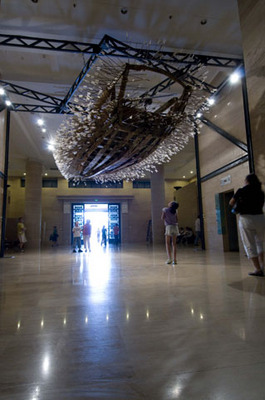
Cai Guo-Qiang, Borrowing Your Enemy's Arrows, 1998. Installation view, National Art Museum of China, 2008.
Cai Studio, 2008.
This major retrospective, which originated at the Guggenheim in February, opened for a two-week run in Beijing at the exact midpoint of the Olympics, a huge success for NAMOC, the Guggenheim, Cai, China, and the U.S.
3. "Intrude: Art and Life 366" (Zendai MoMA, Shanghai)
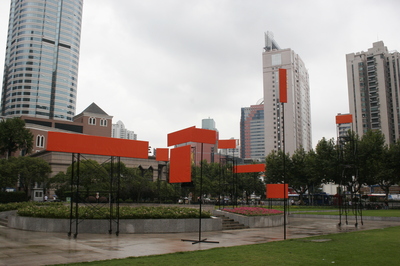
Maider Lopez, Line of Sight, 2008. Installation view, Sheng'ai Square in front of Xujiahui Church, August 29, 2008.
One of the larger projects of the year, Intrude attempted to bring art out of the white cube and into the public sphere. It was an ambitious project, with one artist or work per day, and the different reactions of media, artists, and others made for an interesting year. (I was involved as a member of the curatorial team for this project.) Perhaps its biggest contribution was its attempt to establish dialogues with very different social groups and fields of inquiry that had previously had no contact with contemporary art. At this scale, it becomes difficult to speak of curatorial discourse or critical intent, but it nonetheless created possibilities and opened passages, hinting at future directions for art in Shanghai.
4. Li Ming, "Diary" (Bizart, Shanghai)
Li Ming’s solo exhibition in Bizart was one of the best young artists' exhibitions of the year. In one video, the artist rubs dust and dead skin from his own body in a shadow of light. Other videos show how the artist furthers his explorations through quotidian actions and gestures.
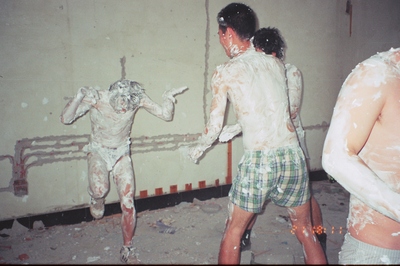
Li Ming, Happy Afternoon, 2008, still from a video.
5. Shopping Gallery (50 Moganshan Road, Shanghai)
For a decade now, Bizart has been perhaps the only true non-profit art space in China. Something changed this year, however, as the group of artists working in Bizart and close to Bizart invested together to open Shopping Gallery in the 50 Moganshan Road complex. Shopping Gallery aims to represent very young artists working mostly in painting, selling their works at bargain-basement prices as the name suggests. Although it has no direct, institutional connection with Bizart, this is one example of how China's market-driven climate has made survival difficult in the non-profit realm.
6. The Sichuan Earthquake (May 12, 2008)
The Wenchuan earthquake remains one of the biggest tragedies of 2008. When things like that happen, one must ask what is the role of art, how artists can act in these situations and what positions they need to take. Many artists went on-site, working on documentaries, raising money, or working as real volunteers and activists. Architect Hsieh Ying-chun is one of these, who actually started a teaching project to show victims how to construct inexpensive temporary housing for themselves.
7. "Comfortable" (Shanghai)
This artist-organized alternative to the Shanghai Biennale was a breath of fresh air to a disappointed city. It is very difficult to talk about any of the individual works, but the unity of the works and the artists in trying to work around a concept is rare in group exhibitions here now. The artists decided to rent small apartment block in the French concession and use it as an exhibition site, taking ideas of "home" and "comfort" as the point of departure for their works. Site specific aspects, combined with readymades and a subtle transformation of the home interior from bathroom to living room gave this exhibition a very special atmosphere that most shows this year lacked.
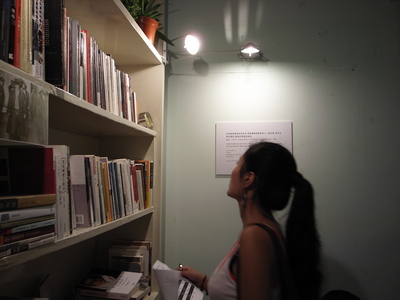
Li Mu, Public Knowledge, 2008. Installation view, "Comfortable," Shanghai, 2008.
8. Qiu Zhijie, "Ataraxic of Zhuang Zi: A Suicidology of the Nanjing Yangzi River" (Zendai MoMA, Shanghai)
One of the most ambitious solo exhibition this year will, Qiu Zhijie's first Shanghai solo outing was hosted by Zendai MoMA and curated by Gao Shiming. The initial array of installation works was impressive, and the artist's research into the phenomenon of suicide from one of the linchpins of socialist infrastructure—the Great Bridge in Nanjing—is ongoing.
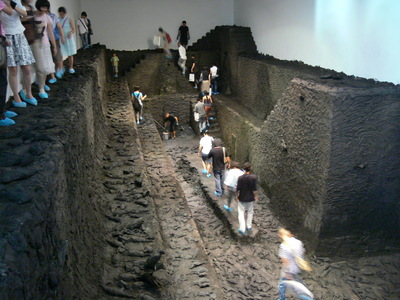
Qiu Zhijie, Thought Loft, 2008. Installation view, Zendai MoMA, Shanghai, 2008.
9. Zheng Guogu, Empire
Zheng Guogu’s sprawling complex in Guangdong is still one of the most interesting artist projects in China. In his native Yangjiang, Zheng has commenced a lifetime project of growing an "empire" that started in 2001 when he bought 20000 square meters of land. His ever-changing experiment is inspired by the computer game Age of Empires. Although it began years ago, it is amazing to see the silent growth and development of project over the course of a decade. Up in Beijing, Cao Fei is building her Second Life empire RMB City, set to "open" to the public later in January.
10. Chinese Biennales
The past year was a year for biennales throughout the region. Three large-scale exhibitions in China—the Shanghai Biennale, Nanjing Triennial, and Guangzhou Triennial—made for busy artists, not to mention the host of "Asian" biennales unfolding across the region. The Shanghai Biennale, themed "Translocalmotion," did not manage to garner much excitement from the art world, although locals still lined up for admission. The Guangzhou Triennial, while initially criticized for its overarticulated theme of a "Farewell to Post-Colonialism," turned out fine, with the curatorial team pulling together a batch of serious work in what has now established itself as the most serious international show in China.
Biljana Ciric is an independent curator based in Shanghai.
source: http://artforum.com.cn/angle/1381
Best of 2008: Biljana Ciric
2009.01.02
1. The Beijing Olympic Games

The Bird's Nest ablaze, August 8, 2008.
It is hard to point to anything other than the 2008 Olympic Games, along with all the expectations and aftereffects they imply. Owing to the importance of both 2008 and 2010 (for which Shanghai is holding a similar countdown to the World Expo), 2009 seems relatively unimportant, which may be a good thing. The Olympics brought tension on many levels, from political to cultural. The involvement of Zhang Yimou and Cai Guo-Qiang in the opening and closing ceremonies led the art world to high expectations. Cai proved his artistic and strategic intelligence, pulling off one of his signature "explosion events" for an entire nation and world.
2. Cai Guo-Qiang, "I Want to Believe" (National Art Museum of China, Beijing)

Cai Guo-Qiang, Borrowing Your Enemy's Arrows, 1998. Installation view, National Art Museum of China, 2008.
Cai Studio, 2008.
This major retrospective, which originated at the Guggenheim in February, opened for a two-week run in Beijing at the exact midpoint of the Olympics, a huge success for NAMOC, the Guggenheim, Cai, China, and the U.S.
3. "Intrude: Art and Life 366" (Zendai MoMA, Shanghai)

Maider Lopez, Line of Sight, 2008. Installation view, Sheng'ai Square in front of Xujiahui Church, August 29, 2008.
One of the larger projects of the year, Intrude attempted to bring art out of the white cube and into the public sphere. It was an ambitious project, with one artist or work per day, and the different reactions of media, artists, and others made for an interesting year. (I was involved as a member of the curatorial team for this project.) Perhaps its biggest contribution was its attempt to establish dialogues with very different social groups and fields of inquiry that had previously had no contact with contemporary art. At this scale, it becomes difficult to speak of curatorial discourse or critical intent, but it nonetheless created possibilities and opened passages, hinting at future directions for art in Shanghai.
4. Li Ming, "Diary" (Bizart, Shanghai)
Li Ming’s solo exhibition in Bizart was one of the best young artists' exhibitions of the year. In one video, the artist rubs dust and dead skin from his own body in a shadow of light. Other videos show how the artist furthers his explorations through quotidian actions and gestures.

Li Ming, Happy Afternoon, 2008, still from a video.
5. Shopping Gallery (50 Moganshan Road, Shanghai)
For a decade now, Bizart has been perhaps the only true non-profit art space in China. Something changed this year, however, as the group of artists working in Bizart and close to Bizart invested together to open Shopping Gallery in the 50 Moganshan Road complex. Shopping Gallery aims to represent very young artists working mostly in painting, selling their works at bargain-basement prices as the name suggests. Although it has no direct, institutional connection with Bizart, this is one example of how China's market-driven climate has made survival difficult in the non-profit realm.
6. The Sichuan Earthquake (May 12, 2008)
The Wenchuan earthquake remains one of the biggest tragedies of 2008. When things like that happen, one must ask what is the role of art, how artists can act in these situations and what positions they need to take. Many artists went on-site, working on documentaries, raising money, or working as real volunteers and activists. Architect Hsieh Ying-chun is one of these, who actually started a teaching project to show victims how to construct inexpensive temporary housing for themselves.
7. "Comfortable" (Shanghai)
This artist-organized alternative to the Shanghai Biennale was a breath of fresh air to a disappointed city. It is very difficult to talk about any of the individual works, but the unity of the works and the artists in trying to work around a concept is rare in group exhibitions here now. The artists decided to rent small apartment block in the French concession and use it as an exhibition site, taking ideas of "home" and "comfort" as the point of departure for their works. Site specific aspects, combined with readymades and a subtle transformation of the home interior from bathroom to living room gave this exhibition a very special atmosphere that most shows this year lacked.

Li Mu, Public Knowledge, 2008. Installation view, "Comfortable," Shanghai, 2008.
8. Qiu Zhijie, "Ataraxic of Zhuang Zi: A Suicidology of the Nanjing Yangzi River" (Zendai MoMA, Shanghai)
One of the most ambitious solo exhibition this year will, Qiu Zhijie's first Shanghai solo outing was hosted by Zendai MoMA and curated by Gao Shiming. The initial array of installation works was impressive, and the artist's research into the phenomenon of suicide from one of the linchpins of socialist infrastructure—the Great Bridge in Nanjing—is ongoing.

Qiu Zhijie, Thought Loft, 2008. Installation view, Zendai MoMA, Shanghai, 2008.
9. Zheng Guogu, Empire
Zheng Guogu’s sprawling complex in Guangdong is still one of the most interesting artist projects in China. In his native Yangjiang, Zheng has commenced a lifetime project of growing an "empire" that started in 2001 when he bought 20000 square meters of land. His ever-changing experiment is inspired by the computer game Age of Empires. Although it began years ago, it is amazing to see the silent growth and development of project over the course of a decade. Up in Beijing, Cao Fei is building her Second Life empire RMB City, set to "open" to the public later in January.
10. Chinese Biennales
The past year was a year for biennales throughout the region. Three large-scale exhibitions in China—the Shanghai Biennale, Nanjing Triennial, and Guangzhou Triennial—made for busy artists, not to mention the host of "Asian" biennales unfolding across the region. The Shanghai Biennale, themed "Translocalmotion," did not manage to garner much excitement from the art world, although locals still lined up for admission. The Guangzhou Triennial, while initially criticized for its overarticulated theme of a "Farewell to Post-Colonialism," turned out fine, with the curatorial team pulling together a batch of serious work in what has now established itself as the most serious international show in China.
Biljana Ciric is an independent curator based in Shanghai.
Best of 2008: Mathieu Borysevicz
2008.12.23
1. Baby Rats
This, the year of the Rat, was the year that I and many others in the Chinese art world became parents. While procreation encompasses a surfeit of physical, emotional and psychological experiences that contemporary art will never achieve, it will certainly inflect the practices of these new parents with a more life-affirming, humble, and purposeful approach to things. Stay tuned for enlightened changes from: artist Yang Zhenzhong and writer Lu Lei, artist Xu Zhen; artist Feng Zhengjie; Beijing-based German photographer Roland Fischer; Galleria Continua's Qiu Keman; curator Tang Xin and artist/designer Xie Wenyue; critic Carol Lu and artist Liu Ding; the artist couple Heidi Voet and Michael Lin, who just last week brought twins into the world, and the countless others who became parents in 2008. Viva Procreation!
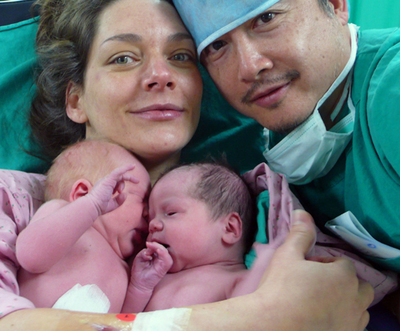
Artists Heidi Voet and Michael Lin with twins Helio and Stella, born December 19, 2008.
2. The Sichuan Earthquake (May 12, 2008)
The Sichuan Earthquake was a humanitarian disaster that spectacularly mobilized millions, the art world included. Not only did several artists (including myself, Ai Weiwei, Zhao Bandi, Hu Xiangcheng, and Luo Ping) personally visit the devastation, but serious money was raised by impromptu charity auctions and other art-world contributions. From a formal point of view, the media’s role in galvanizing the masses was epic. The grand, theatrical narrative of devastation, conspiracy and bereavement played out for months across a myriad of media throughout China and around the globe. On televisions, billboards, and the Internet, real-life tragedy was transformed into fiction and vice versa. Premier Wen Jiabao cried, heroic soldiers rescued, and countless victims were and are still mourned.
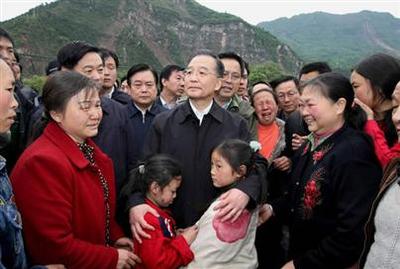
Premier Wen Jiabao visits the site of the Wenchuan Earthquake, May, 2008.
3. Hipic.org
In this accelerated age of incessant media clamor and digital instantaneity, the world, and thus our consciousness, overflows with photographic images. It would be impossible to estimate the number of digital photographs produced each day or even each second on this planet. BizArt’s Hipic takes an imaginary stab at this enigma. Hipic is a computational machine that recycles digital images as a communal, time-based, artwork, both online and in public, one minute at a time for the rest of time...or as long as participants continue to contribute to the piece by uploading their own photos. At the time of writing this, Hipic was one year, three months, nine days, fifteen hours and seven minutes old; or close to 600,000 images long. Online or in public installations, Hipic’s images progress in an illogical though steady stream, one minute at a time, forming an ambience of constantly changing vistas.
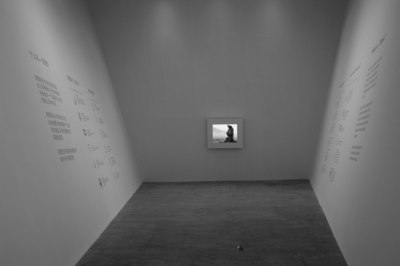
Hipic terminal mounted at ShanghART Gallery, Beijing, February, 2008.
4. Beijing 2008 Summer Olympics
Looking back it’s funny long ago the Olympics seem already. Was that August or 1999? Now matter how much we’d love to forget the Olympics, the Games became an integral part of contemporary Chinese culture, not only in their conscription of some of China’s most famous artists but in their omnipresent hold on our consciousness. While the pre-Olympic run-up saw the formation of a governing ideology based on magnitude, national pride, and promise, the actual games—from the architecture, to the over-anticipated, super-elaborate, Cai Guo-Qiang-embellished opening performances, to Liu Xiang’s tragic Achilles heel injury (which threw the entire nation into a psychoanalytical blame game), to the surreality of a closing ceremony accented by Led Zeppelin’s aging guitarist Jimmy Page playing Whole Lotta Love atop a transforming double-decker bus—were truly a feast.
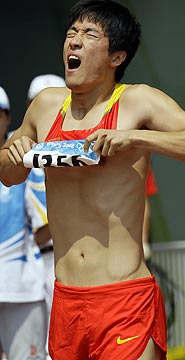
Liu Xiang reeling in pain during a qualifying heat for the men's 110-meter hurdles, Beijing, August 2008.
5. "Comfortable" (Shanghai)
The critic Gao Minglu in his seminal exhibition Inside/Out, identified a movement he dubbed "apartment art" amidst the work produced in early-1990s China. No matter how well this label fits the work of artists who basically had no other venues at the time, Shanghai was host to its own version of apartment art this autumn. Amidst the hoopla of the Shanghai Biennial and the second incarnation of the ShContemporary fair, artist Jin Shan and others organized a small but very refreshing exhibition inside an old lane house in the French Concession. The exhibition seemed to begin well before reaching the venue itself, in the laundry-strewn alleyways and slightly dilapidated halls that doubled as communal kitchens. The event’s casual, DIY strategy was antithetical to the other art events in the city at the time. An installation of visitors’ shoes (Lu Yonglei) greeted newcomers to the exhibition while people dressed only in red imitation Calvin Klein undies and printed white t-shirts (Alexandre Ouairy) lounged about everywhere. An air conditioner unit installed inside out heated up the space and leaked water all over (Jin Shan), while in another room a floor of cushioned tiles (Tang Dixin) made walking impossible. This lived-in, funhouse sensibility gave the participant a feeling of being part of a teenage fantasy experiment rather than an exhibition.
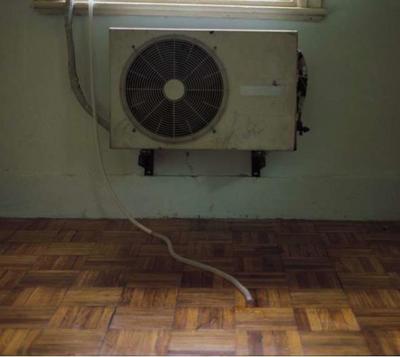
Jin Shan, Decrease the Temperature of Shanghai by 0.0001 Degree, 2008. Installation view, "Comfortable," Shanghai.
6. David Byrne, Playing the Building (New York)
David Byrne is one of those artists who traverse mediums and forms with exquisite ease. With operas, films, music production, music curating, books, blogs, furniture, photography and The Talking Heads behind him what else can he possibly do? This summer as part of Creative Time’s ongoing series of public works, Byrne transformed lower Manhattan’s Battery Maritime Building into an interactive musical instrument. Opening at the same time as Olafur Eliasson’s much-hyped, fifteen-million-dollar waterfall installations, Byrne’s piece instead used low-key, lo-fi technology to magically resuscitate a dilapidated building. The piece was composed of a reconfigured antique organ from which plastic tubes strung out in an elegant web and attached to various parts of the cavernous building. When the organ’s keys were pressed, air pumped through the tubes eliciting various clanking or blowing noises from the building’s nineteenth-century structure and delighting participants.
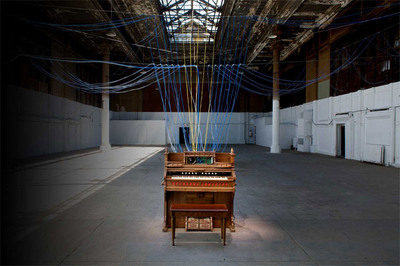
David Byrne, Playing the Building, 2008. Installation view, Battery Maritime Building, New York.
7. "Intrude: Art & Life 366" (Zendai MoMA, Shanghai)
Zendai MoMA's Intrude: Art & Life 366 series was a bit too ambitious to truly succeed. The project’s goal was simple: on each of the 366 days of 2008, a different artwork would intervene in Shanghai’s public realm. It was an earnest attempt to cross-breed reality with the esoteric realm of contemporary art, to infiltrate new territories and reach new audiences. Art & Life 366 was a good idea but very difficult to manage, promote, document or realize in general. Having said this, 366 saw a formidable slew of local and international artists working in areas where they had hitherto never been, for audiences that never expected them. Some highlights included Vibeke Jensen’s nighttime video projections on Shanghai’s cultural institutions, Bai Yiluo’s oversized human heart being driven around on the back of a tricycle cart, Yoko Ono’s Instructional pieces and Yang Yong’s photographs as subway posters, and Utopian Group’s museums in private homes project, to name just a few.
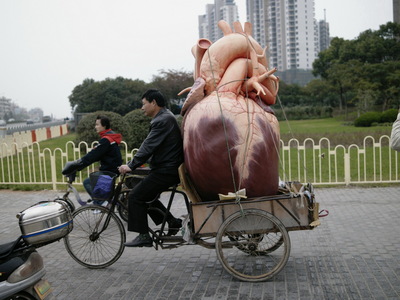
Bai Yiluo, Harvest, 2008. Performance view, "Intrude: Art and Life 366," Shanghai, 2008.
8. The US Presidential Election and Obama Mania
Need I say more?
9. "Farewell to Post-Colonialism: The Third Guangzhou Triennial" (Guangdong Museum of Art, Guangzhou)
While the exhibition itself was a lovely, epic mess, it is the convoluted, multilayered, almost suicidal criticality of the exhibition’s grounding theory that gets the award here. One of the grand curatorial conceits of this year’s Guangzhou Triennial is that art practices today are endangered by a reality that is increasingly fanciful and increasingly confounded by the expansion of mass media and the proliferation of nonlinear technology. Triennial curator Gao Shiming identified this as the virtual world colonizing the real world. Like this very non-linear list that I am writing (which includes entries belonging not to the art world but to our greater communal reality) the Triennial’s audacious title, “Farewell to Post-Colonialism,” was incongruous in its setting. Not only does Mainland China have no formal colonial history, but it wasn’t until the mid-1990s that post-colonial (not to mention colonial) discourse entered China. Like many other popular post-modern theories, it arrived as a Western import. Post-colonialism not only helped to reinforce the traditionally bipolar view of East vs. West in China but also became a ready-made conceptual framework for its contemporary arts. It is a framework, some may argue, that has allowed the contemporary arts of China to thrive. And now in only the third manifestation of the triennial this ideology was getting laid to rest, because the world today is a lot more complicated than that. Thank God.
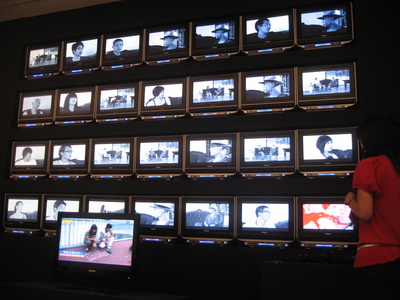
Liu Wei, Lying, 2008, video installation. Installation view, Guangdong Museum of Art.
10. Yang Fudong, East of Que Village (ShanghART Gallery)
David Velasco in writing about the same exhibition for artforum.com called East of Que Village “a ravishing study of antagonism on the fringes.” MoMA curator Barbara London confessed in conversation that she thought the piece was the artist’s most political and personal to date. After seeing Yang Fudong’s latest video creation I’m still not exactly sure what either of these comments mean, but somehow they both seem accurate. East of Que Village is a six-screen video installation that posits wild dogs as protagonists in a loose, survival-of-the-fittest narrative. While this pack of dogs scrape the sustenance out of a dusty, barely populated northern town, an oddly hierarchical group dynamic emerges amongst them. Perhaps the dynamic is one that we project upon them, as survivalists ourselves.

Yang Fudong, East of Que Village, 2007, still from a six-channel video projection, 20 minutes 50 seconds.
Mathieu Borysevicz is an artist, curator, and frequent contributor to Artforum.
— 文/ Mathieu Borysevicz
Best of 2008: Anthony Yung
2008.12.18
1. Alexander Kluge, The Films for Cinema (Edition Filmmuseum)
For ages I (and many others, I believe) have been waiting for Kluge's iconic Artists under the Big Top: Perplexed to be released on DVD. To see and collect more than fifty major cinematic works of Kluge in this set of eight two-disc DVDs is no doubt great, as is the surprise of the set's rich supplementary materials, such as Kluge's inspiring interview with Jean-Luc Godard in 2001 and some of his experimental television productions.
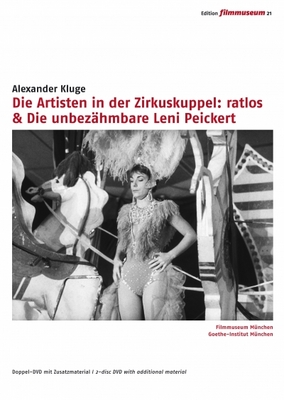
Cover of Alexander Kluge's Artists under the Big Top: Perplexed (1968, DVD Edition Filmmuseum 2008).
2. "Farewell to Post-Colonialism: The Third Guangzhou Triennial" (Guangdong Museum of Art, Guangzhou)
The Triennial's opening was a wonderful day. The museum decided to hold the opening forum in a secondary venue, a residential real-estate development forty minutes from the city center. In this half-finished apartment block, smells of formaldehyde, rain, and perfume mingled amidst the work on view. Viewers crammed into the single elevator connecting the several floors displaying work with the tenacity of Hong Kong subway commuters at rush hour. Triennial curator Johnson Chang was enamored of the way in which this space allowed chaos and possibilities to yearn for each other. Another simple but great innovation was the show's system of overseas research curators. This team of seven introduced many good foreign artists, who were probably quite established in their own regions if virtually unknown in China.
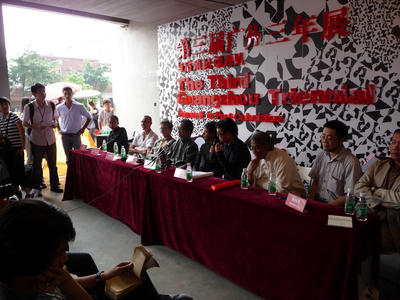
Opening press conference for "Farewell to Post-Colonialism: The Third Guangzhou Triennial," Guangzhou, September 6, 2008.
3. Ishii Yuya, Stranger than Hysteria, 2008
By far the best program of the 32nd Hong Kong International Film Festival was this screening of four films by Ishii Yuya. To quote the festival's official program book: "Even when we showed Ishii Yuya's work to the initiated, the usual response was: 'Where the #$%^ did this guy come from?'" The 25-year-old director has already appeared at many international film festivals and is frequently suspected of insanity after his screenings. Ishii's films remind me of the early works of Nobuhiro Yamashita: low-tech, low-budget, lo-fi; funny but upsetting; mundane but absurd; surprising but desperate. In a word, Japanese, very Japanese.
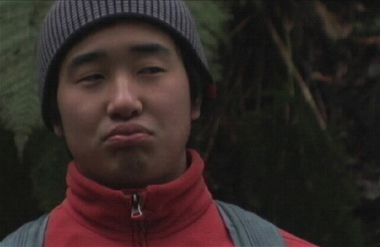
Ishii Yuya, Rebel Jiro's Love, 2006, still from a color film.
4. Wu Shanzhuan, But Still Red, Red Humour International (Guangdong Museum of Art, Guangzhou)
This is the first solo exhibition of Wu Shanzhuan in China. Wu is one of the earliest conceptual artists of the ’85 New Wave. His works are famous for their humor: playful but difficult and philosophical. The exhibition featured nearly all of his representative work from his thirty-year career. With the show published he published not a catalogue but a 793-page novel Today No Water. This "novel" actually seems to be a compilation of Wu’s writings from all these years, including a lot of possible explanations and elaborations of the whole structure of his unique theories.
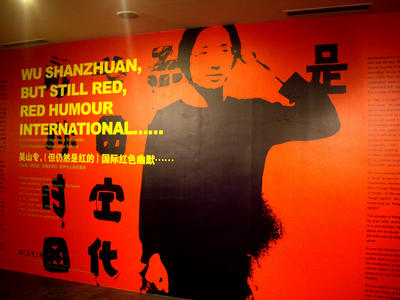
View of Wu Shanzhuan, "But Still Red, Red Humour International," Guangdong Museum of Art, Guangzhou, 2008.
5. Carlos Garaicoa, "¿Revolución o Rizoma?" (Galleria Continua, Beijing)
I will not go into the philosophical meaning of the "rhizome," but for those who find the work of Gilles Deleuze and Félix Guattari just too difficult to read, I recommend this exhibition by Carlos Garaicoa. The work that amazed me most was the sculpture An Oriental Minute in Occidental Music, where different kinds of musical instruments were hooked inside a glass box, and people could use a stethoscope to listen to the music inside. Two works from this show were later shown in the Guangzhou Triennial, where they similarly stood out.
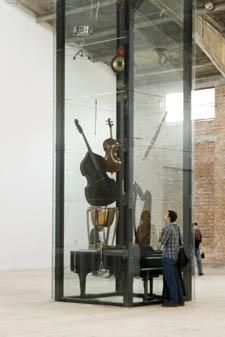
Carlos Garaicoa, Minuto Oriental en la Musica Occidental (An Oriental Minute in Occidental Music), 2008, musical instruments, glass, metal, stethoscopes, wire. Installation view, Galleria Continua, Beijing, 2008.
6. "Looking for Antonio Mak" (Hong Kong Museum of Art)
The third and best exhibition in the museum's “Open-Dialogue” series, this show presented more than one hundred works by the legendary Hong Kong sculptor Antonio Mak (1951-1994) alongside new commissions by seven artists responding to his short and brilliant career. Mak's early death, along with the paucity of his work in the public sphere, had made him an enigma. The exhibition, curated by Valerie Doran, includes a notable research section that helps viewers to recollect and rediscover Mak's life and work.

Antonio Mak Hingyeung, Good Morning II, 1983, bronze. Installation view, Hong Kong Museum of Art, 2008.
7. Michelangelo Pistoletto (Galleria Continua, Beijing) (Exhibition)
It’s strange that in Beijing to see huge installation works by masters like Anish Kapoor or Pistoletto, you don't go to a big, national museum but to a commercial gallery, and always the same one no less. This exhibition featured Pistoletto's classic works The Labyrinth and The Cubic Meter of Infinity in a Mirroring Cube, both produce fine spectacles that words can't describe. Whatever one can say about the taste of the Chinese audience, I observed that they enjoyed this show much more than seeing those acrylic cartoon heads.
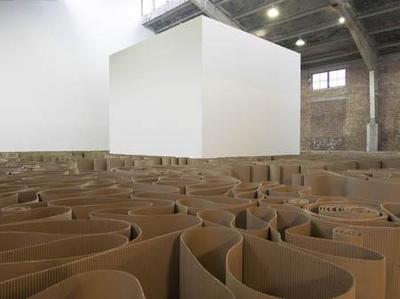
View of "Michelangelo Pistoletto," 2008, Galleria Continua, Beijing. Foreground: The Labyrinth, 1969-2007.
8. Yelang and the Nanman Band, Greatest 08
A friend and owner of a record store next to the Guangzhou Academy of Fine Arts recommended Yelang to me. His music is a mixture of Psycho-Fork and Chinese minority-nationality folk. He tends to use local musical instruments, with names I am unable to translate. He sings in Guangxi dialect. This poorly designed, homemade record features five tracks. The lyrics, I suspect, come just from traditional folk songs: one is about the old house in which he spent his childhood; another marks a promise to his mother that one day he will marry a beautiful and good wife and return home. To be honest, I don't think there is much chance you see this CD anywhere, but I do hope that more of his music will come out.

Cover of Yelang and the Nanman Band, Greatest 08.
9. "Mute: Zhang Peili's Solo Exhibition" (OCT Contemporary Art Terminal, Shenzhen)
In September, three exhibitions opened together in Shenzhen's "Overseas Chinese Town," including a 50-artist survey called "Hypallage," a retrospective of Wang Guangyi's non-painting works, and this solo show by Zhang Peili. Among the three, Zhang's show was the smallest in scale, featuring only one installation work, but it was easily the best. Zhang brought from Zhejiang province the machinery of an entire textile factory, but he only brought the workers via his videos. The factory still makes dirt and noises, but nothing is produced. With the exhibition was published a wonderful catalogue, printing most of Zhang's major works and interviews.

View of "Mute: Zhang Peili's Solo Exhibition," OCT Contemporary Art Terminal, Shenzhen, 2008.
10. Julio Cortazar, Rayuela, Chinese translation by Sun Jiameng (Chongqing Publishing House)
Although Cortazar's novel was originally published in 1996 as part of the "Latin American Literature Series," this new version features improved translation, editing and printing. I grew so obsessed that I wasn't able to put it down for quite some time. A conversation with one bookshop owner revealed that this book is surprisingly popular among Chinese readers, so we have some hopes that the publishers might want to release other works by Cortazar in coming years. I, for one, am looking forward.
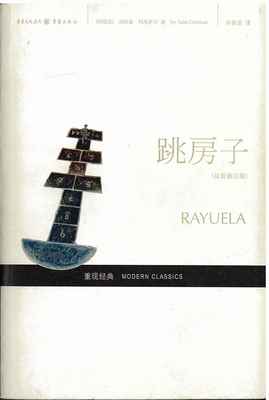
Cover of Julio Cortazar Rayuela, trans. Sun Jiameng, Chongqing Publishing House, 2008.
Best of 2008: Davide Quadrio
2009.01.07
1. Takeshi Murata (Shanghai e-Arts Festival)
Using an eight-story, round LED screen for an original production is the experience of a lifetime for an artist. Takeshi Murata was able to create an amazing piece for this huge screen. His abstract animation looked perfect once installed, lighting up Xujiahui with an unexpected and ultimately unavoidable piece of art.
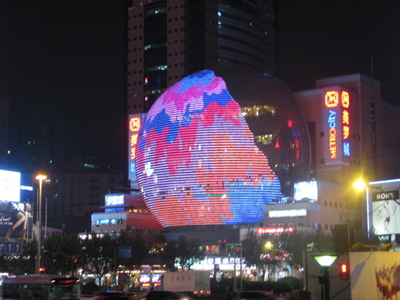
Takeshi Murata, projection for Shanghai E-Arts Festival, Xuhui Financial District, Shanghai.
2. "Eastern Standard: Western Artists in China" (Mass MoCA, North Adams, Massachusetts)
There is a huge debate in the Chinese intellectual and art worlds about the legitimacy of commenting on matters Chinese, be it from an academic or political point of view. There is a nagging suspicion that excessive reliance on "Chinese" symbols, signifiers, or questions amounts to pandering. Artist Wang Jianwei recently wrote a text on this matter, asking, “Why do we need to talk about China, now? Why do we always need to think about this country as special?" His answer is of course that it is not special, but the very terms of the debate play into the hands of the national and international media. Yet despite the reservations of many intellectuals, artists and curators, China remains fertile ground for artistic research. And why shouldn't it? This exhibition at Mass MoCA gives a very welcome answer to this tedious matter alongside an introduction of how China can be legitimately at the center of artistic research no matter where the artists come from. The exhibition, curated by Susan Cross, was a refreshing and legitimate curatorial choice.
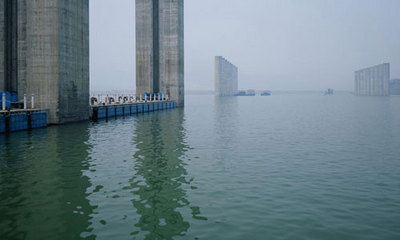
Catherine Yass, Lock, 2006. Still from a film installation.
3. Xu Zhen, "Impossible is Nothing" (Long March Space, Beijing)
Xu Zhen's work once again leaves a trace. This solo exhibition is complex and somehow reveals the grandeur of an artist who is surely one of the most interesting in China. The cynical attitude and distance that Xu Zhen is always able to bring into his creations put this exhibition just on the verge of being one of the most daring he has made.
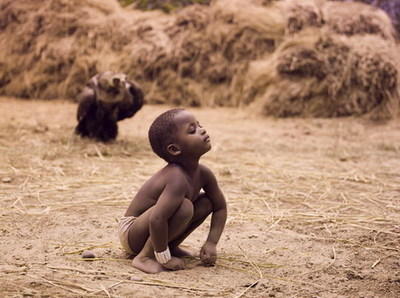
Xu Zhen, The Starving of Sudan, 2008. Installation view, Long March Space, Beijing.
4. Qiu Zhijie, "Ataraxic of Zhuang Zi: A Suicidology of the Nanjing Yangzi River" (Zendai MoMA, Shanghai)
I love Qiu Zhijie's profound artistic and philosophical commitment, as well as his commitment to creating an artistic discourse that goes beyond banalities. All of these show themselves in this excellent solo show. The first part of the show involved an installation comprising black/ink machines/butterflies/crows, which in its gloom reminded me of underground exhibitions likePost-Sense Sensibility (1999). If the exhibition had its highs and lows, in the end the work was strong and the subject remains relevant, historically and sociologically.
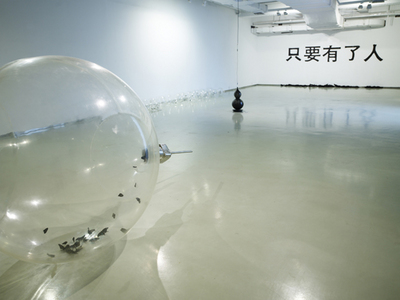
Qiu Zhijie, If Only We Have People, 2008. Installation view, Zendai MoMA, Shanghai, 2008.
5. Yang Fudong, East of Que Village (ShanghART Gallery)
East of Que Village is finally a complex video installation by Yang Fudong that brings back the energy and the unconventional storytelling the artist was known for in his early years. I enjoyed the piece very much, still built with an incredibly natural skill to capture beauty even in such a disturbing and disrupting environment.
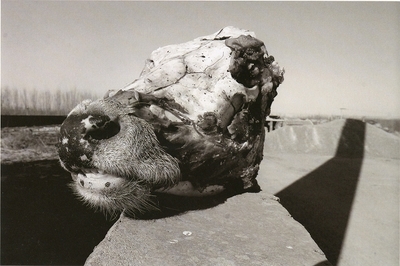
Yang Fudong, East of Que Village, 2007, still from a six-channel video projection, 20 minutes 50 seconds.
6. Meng Huang, "And What Do You Think? Landscapes" (Galerie Urs Meile, Beijing)
Meng Huang is at once a painter of amazing skill, a philosopher, and a storyteller. He is a true artist, building a body of work from his journey through life. This exhibition was perfectly installed, and featured an amazing eight-panel composition Dam, 3.5 meters high and nearly 18 meters long. His work is a counter-statement to the tendency of many Chinese artists toward going big to impress in a superficial way. The size of this piece is indeed overwhelming, and gives back the original drama that the dam has hidden for decades.
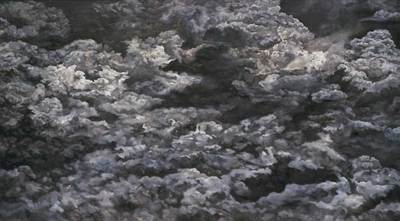
Meng Huang, Clouds, 2008, oil on canvas, 220 x 400 cm.
7. Kan Xuan, "Kanxuan! Ai!" (Galleria Continua, San Gimignano, Italy)
Kan Xuan’s work is always a natural surprise. This solo exhibition was like a mini-retrospective, full of the pieces I know from a decade ago when we were both beginning our involvements in the Chinese art scene. The title of the exhibition is actually the title of the video installation she presented in the iconic group exhibition Art for Sale (1999), which was her debut in China. Her work never fails to convey a feeling of psychological “transfer” between artist and viewer. Looking at it, time and again, I feel pulled into her mission as an artist, which in turn responds to my attitude as a curator and art activist. The iconoclastic power of her work (subtle, never shouted) is well described by what she once said to me: “I want to go back to what is important to me, making good artwork, despite any pressures from galleries, dealers, producers, etc. It is only me that counts, and my art. That is what I value the most.”

Kan Xuan, Kanxuan! Ai!, 1999, video, 1:22.
8. Isidro Blasco, "When I Look at It" (Contrasts Gallery, Shanghai)
This exhibition on Shanghai done in Contrasts Gallery is perhaps the best the gallery has yet mounted. Blasco's work is truly refreshing with a formal maturity and a decorative hint that is never disturbing. Never exoticizing, it manages still to offer a kaleidoscopic image of Shanghai's lanes and alleys

Isidro Blasco, Building 2, 2007.
9. "House of Oracles: A Huang Yong Ping Retrospective" (Ullens Center for Contemporary Art, Beijing)
The exhibition is refreshing in its condensed presentation of the body of work by an artist as accomplished as Huang Yong Ping. If the presentation was sometimes a bit too crowded and some pieces suffered a bit because of it, the documentary section at the end of the show—especially the documentation of some Xiamen Dada performances—was outstanding. It is truly refreshing to see in China pieces of such intensity. In this particular situation in China art world, nothing is more correct that what the late artist Chen Zhen wrote in the 1990s in his fake interview “Transexperiences, A conversation between Chen Zhen and Zhu Xian”:
“My "identity genes" are yellow. But owing to various limitations, I could not carry out in China the type of work I am doing. Therefore, we formed a group of "cultural tramps." Seized by wanderlust, we want to be on the move all the time. Although I participated in some "Chinese exhibitions," I never embraced the sense of "representing" China. Once, a Western curator responsible for organizing a Chinese exhibition asked me, "What are you thinking about now?" I replied, "I am thinking about what I should do as an individual once the 'China fever' in the western world dies down." You know, every time I go to Venice Biennale, I always feel pitiful for never seeing a Chinese Pavilion there so far. However, after mulling it over, the question seems to have turned around: how could an artist represent only one nation and exhibit his works in only one national pavilion?"
Huang Yong Ping's work as presented in this exhibition is truly a “world” art, not confined by national boundaries.
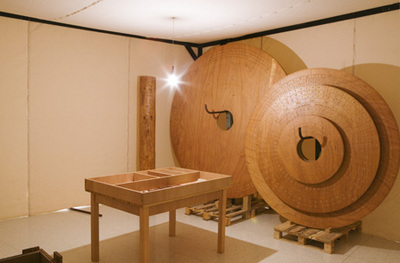
Huang Yong Ping, The House of Oracles, 1989-92. Installation view, Walker Art Center, 2005.
10. "Intrude: Art and Life 366" (Zendai MoMA, Shanghai)
This series of daily accidents was supposed to be-and in theory has been-a year-long event. Unfortunately even though some events were truly interesting, most of the original idea got lost in a range of unprepared and “occasional” events, not really connected to the city and not really changing the perception of public art in China. This is yet another example of how great ideas can be reduced to a presence online or in a catalogue but really do not have the strength to be truly “consistent.” This happens still too often.
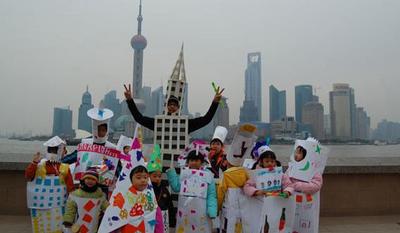
Kacey Wong, Body as Architecture, 2008. Performance view, Intrude: Art and Life 366, Shanghai.
Davide Quadrio is a curator and co-founder of BizArt Art Centre in Shanghai and Arthub. He is currently based in Bangkok.
Best of 2008: Bert de Muynck
2009.01.01
1. China Academy of Arts Xiangshan Campus (Amateur Architecture Studio, Hangzhou)
The new Xiangshan campus of the China Academy of Arts (CAA) in Hangzhou ranks among China's most intriguing works of architecture from the last few years. Designed by Wang Shu and Lu Wenyu – principals of Amateur Architecture Studio and professors at the Academy – the campus updates the notion of “critical regionalism.” In the architects' words, the campus, by “creating layers of depth, adopting cross-references and modern interpretations on traditions," offers "templates for a modern take on the old pagodas, temples, courtyards, and mountains.” The campus is a remarkable example of critical architectural experimentation, balancing between modernism and tradition while remaining distinctively Chinese in its identity.
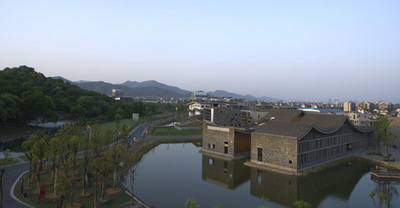
Amateur Architecture Studio, China Academy of Arts Xiangshan Campus, 2008, Hangzhou.
2. National Stadium (Herzog & de Meuron, in collaboration with Ai Weiwei, Beijing)
The unavoidable masterpiece of the 2008 Beijing Olympic Games. An instant classic of modern architecture, both timeless and placeless, even if the “Bird's Nest” could not have been build anywhere else than in Beijing in these times. Nothing can be added to the pre-Olympic appraisal of this collaboration between Swiss architects Herzog & de Meuron and Chinese artist-architect Ai Weiwei. The building is not about words but about welding.
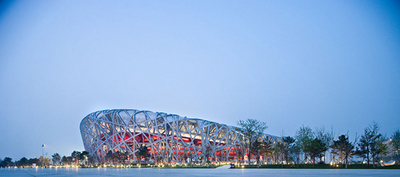
Herzog & de Meuron, National Stadium, 2008, Beijing. Photo: Iwan Baan.
3. ORDOS100 (Curated by Ai Weiwei, Ordos, Inner Mongolia)
During the first half of 2008, 100 international architects from 27 countries were invited to each design a villa of 1000 square meters, in Ordos, Inner Mongolia. Scheduled for construction in 2009, ORDOS100 is an interesting test case in the field of architecture to understand the impact of China’s Creative Industries ambitions, both as an urban and cultural model, as a real-estate investment (developer Cai Jiang), a curatorial practice (artist Ai Weiwei) and policy implementation (the local government of Ordos). The outcome of this project will be a high-end residential setting, to some akin to a World Expo, while to others it looks more like Beverly Hills or an architectural zoo. There is certainly an element of creative roughness, if not brutality, in inviting 100 architects for this project. As it currently stands, ORDOS100 is clearly is an experiment in the production of a new architectural culture in China, irrespective of its shortcomings.
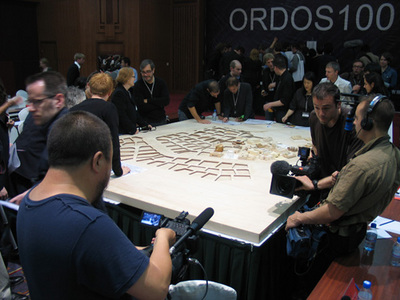
Design meeting for the Ordos 100 project, April 2008, Ordos. Photo: MovingCities.
4. Museum of China Central Academy of Fine Arts (Arata Isozaki, Beijing)
The Museum of China Central Academy of Fine Arts is one of the most overlooked new contributions to the development of modern architecture in the capital. Bringing curves to its campus, the architect managed to create a solid volume which from the inside feels spacious and bright. Balancing in space and material the light and the heavy, the inside and the outside, Isozaki brings a new architectural language to the city, in line with the objectives of creativity on the campus, even as he furthers his knowledge and experience in building cultural institutions that are pieces of art in themselves.
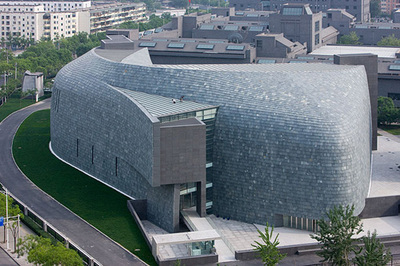
Arata Isozaki, Museum of China Central Academy of Fine Arts, 2008, Beijing. Photo: Iwan Baan.
5. Beijing Capital Airport (Foster + Partners)
For many the unavoidable gateway to China. Constructed at break-neck speed, and designed by the British architect Norman Foster, the building was hailed for its capacity to be contextual and Chinese (a point perhaps best left up for discussion). In form akin to a dragon and using "traditional" Chinese colors – imperial reds merge into golden yellows – the airport is a true twenty-first century temple of transport. Despite its megalomanic size, the architect managed to balance the bold with the bright. A well laid-out forest of columns gives the space the powerful drama one can expect from one of China's most important buildings, creating a sense of ephemerality and temporality that goes along with travelling. The architecture impresses masses perfectly for two-hour intervals. After that one is more than happy to leave it. The perfect pass-through architecture.
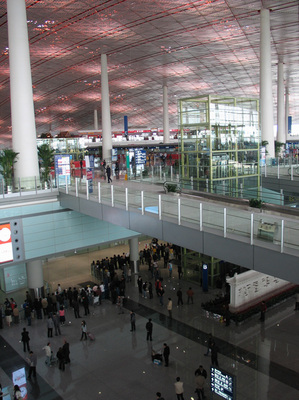
Foster + Partners, Beijing Capital Airport Terminal 3, 2008, Beijing. Photo: MovingCities.
6. Paper-Brick House (Atelier Li Xinggang, Venice)
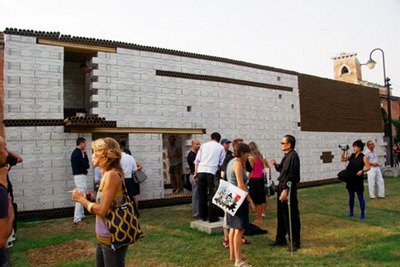
Atelier Li Xinggang, Paper-Brick House, 2008, Venice.
7. RMB City (Cao Fei, Second Life)

Cao Fei, RMB City 5, 2008, digital c-print, 120 x 160 cm.
8. Foreign journalists describing Beijing's urban and architectural development (August, 2008)
The best of the worst. In the pre-Olympic times the foreign media undertook desperate attempts to get a grip on the architectural and urban situation in Beijing. A series of hit-and-run articles on Beijing were all centred around the the media’s obsession with the Water Cube, the Bird’s nest, CCTV, Linked Hybrid and the Egg. Contributions like From Mao to Wow! (Vanity Fair), In Changing Face of Beijing, a Look at the New China (New York Times), Secrets of the Bird’s Nest (The Guardian), Forbidden Cities (The New Yorker), Out of the Blocks (The New Yorker),… were nauseating and debilitating middle of the road contributions to “a debate” on the state of affairs of architecture in China.
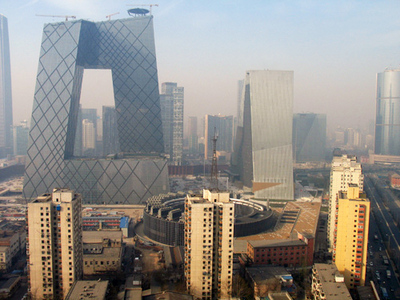
Beijing's skyline in late 2008. Photo: MovingCities.
9. The Green Revolution
A lot of focus this year on sustainability, green design and environmental design. A few projects stand out: The Green Dragon, a documentary film about the potential for expanding sustainable construction and development in China (http://www.greendragonfilm.com/), Ming Tang’s origami-inspired Folded Bamboo Houses (intended as temporary shelters for the victims of the Sichuan earthquake) and the University of Nottingham’s new Centre for Sustainable Energy Technologies (CSET) in Ningbo by Mario Cucinella Architects.
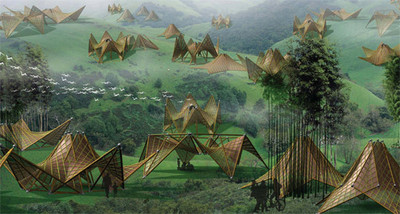
Ming Tang, Folded Bamboo Houses, 2008, Sichuan.
10. 0300TV, China According to China, 2008
With disclaimer as the author is featured in foreword to this documentary. Completely filmed by Diego Grass Puga and 0300TV before 2008’s Beijing Olympics and edited right after its ending, China According to China presents a set of thoughts by five local architects on China’s current situation and history. Ai Weiwei (FAKE design), Jiang Jun (Urban China), Yu Kongjian (Turenscape), Wang Shu (Amateur Architecture Studio) and Ma Qingyun (MADA s.p.a.m.) are in charge of defining the issues that every Chinese architect has to deal with in today’s practice, all of which may set the parameters of future development for Chinese architecture.
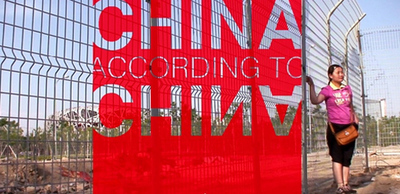
Publicity still for China According to China, 0300TV, 2008.
Bert de Muynck is an architect and urbanist based in Beijing.
The architectural apotheosis of the Chinese city built in a virtual world. Developed by Chinese artist Cao Fei, RMB City offers an intense China experience. Combining the surreal with the virtual, critique with commerce, RMB City is an exercise in suspension that uses a dimensional distortion of architecture to create something which is described as “a city.” A place impossible to live in, but potentially an interesting one to invest in.
Taking “Ordinary Architecture” as its general theme, the Chinese Pavilion at the Venice 2008 Architectural Biennale presented an exhibition including the work of five Chinese architects: Liu Jiakun, Tong Ming, Ge Ming, Li Xinggang, Liu Kecheng, and photographer Wang Di. The exhibition was curated by Yung Ho Chang, Acheng Zhong and Gong Yan. Li Xinggang's “paper-brick house” is an attempt to build in a straightforward way. Walls are made out of cardboard boxes that act as "paper bricks" while paper tubes are used as beams. This lightweight structure both reflects on the poor quality of the heavier constructions that characterize the Chinese city. Although not totally original, the pavilion offers an intriguing response, according to its architect, “to reflect on the tragedy that has buried tens of thousands of people in Sichuan–a direct result of the reinforced concrete buildings’ inferior quality.”
2009.01.01
1. China Academy of Arts Xiangshan Campus (Amateur Architecture Studio, Hangzhou)
The new Xiangshan campus of the China Academy of Arts (CAA) in Hangzhou ranks among China's most intriguing works of architecture from the last few years. Designed by Wang Shu and Lu Wenyu – principals of Amateur Architecture Studio and professors at the Academy – the campus updates the notion of “critical regionalism.” In the architects' words, the campus, by “creating layers of depth, adopting cross-references and modern interpretations on traditions," offers "templates for a modern take on the old pagodas, temples, courtyards, and mountains.” The campus is a remarkable example of critical architectural experimentation, balancing between modernism and tradition while remaining distinctively Chinese in its identity.

Amateur Architecture Studio, China Academy of Arts Xiangshan Campus, 2008, Hangzhou.
2. National Stadium (Herzog & de Meuron, in collaboration with Ai Weiwei, Beijing)
The unavoidable masterpiece of the 2008 Beijing Olympic Games. An instant classic of modern architecture, both timeless and placeless, even if the “Bird's Nest” could not have been build anywhere else than in Beijing in these times. Nothing can be added to the pre-Olympic appraisal of this collaboration between Swiss architects Herzog & de Meuron and Chinese artist-architect Ai Weiwei. The building is not about words but about welding.

Herzog & de Meuron, National Stadium, 2008, Beijing. Photo: Iwan Baan.
3. ORDOS100 (Curated by Ai Weiwei, Ordos, Inner Mongolia)
During the first half of 2008, 100 international architects from 27 countries were invited to each design a villa of 1000 square meters, in Ordos, Inner Mongolia. Scheduled for construction in 2009, ORDOS100 is an interesting test case in the field of architecture to understand the impact of China’s Creative Industries ambitions, both as an urban and cultural model, as a real-estate investment (developer Cai Jiang), a curatorial practice (artist Ai Weiwei) and policy implementation (the local government of Ordos). The outcome of this project will be a high-end residential setting, to some akin to a World Expo, while to others it looks more like Beverly Hills or an architectural zoo. There is certainly an element of creative roughness, if not brutality, in inviting 100 architects for this project. As it currently stands, ORDOS100 is clearly is an experiment in the production of a new architectural culture in China, irrespective of its shortcomings.

Design meeting for the Ordos 100 project, April 2008, Ordos. Photo: MovingCities.
4. Museum of China Central Academy of Fine Arts (Arata Isozaki, Beijing)
The Museum of China Central Academy of Fine Arts is one of the most overlooked new contributions to the development of modern architecture in the capital. Bringing curves to its campus, the architect managed to create a solid volume which from the inside feels spacious and bright. Balancing in space and material the light and the heavy, the inside and the outside, Isozaki brings a new architectural language to the city, in line with the objectives of creativity on the campus, even as he furthers his knowledge and experience in building cultural institutions that are pieces of art in themselves.

Arata Isozaki, Museum of China Central Academy of Fine Arts, 2008, Beijing. Photo: Iwan Baan.
5. Beijing Capital Airport (Foster + Partners)
For many the unavoidable gateway to China. Constructed at break-neck speed, and designed by the British architect Norman Foster, the building was hailed for its capacity to be contextual and Chinese (a point perhaps best left up for discussion). In form akin to a dragon and using "traditional" Chinese colors – imperial reds merge into golden yellows – the airport is a true twenty-first century temple of transport. Despite its megalomanic size, the architect managed to balance the bold with the bright. A well laid-out forest of columns gives the space the powerful drama one can expect from one of China's most important buildings, creating a sense of ephemerality and temporality that goes along with travelling. The architecture impresses masses perfectly for two-hour intervals. After that one is more than happy to leave it. The perfect pass-through architecture.

Foster + Partners, Beijing Capital Airport Terminal 3, 2008, Beijing. Photo: MovingCities.
6. Paper-Brick House (Atelier Li Xinggang, Venice)

Atelier Li Xinggang, Paper-Brick House, 2008, Venice.
7. RMB City (Cao Fei, Second Life)

Cao Fei, RMB City 5, 2008, digital c-print, 120 x 160 cm.
8. Foreign journalists describing Beijing's urban and architectural development (August, 2008)
The best of the worst. In the pre-Olympic times the foreign media undertook desperate attempts to get a grip on the architectural and urban situation in Beijing. A series of hit-and-run articles on Beijing were all centred around the the media’s obsession with the Water Cube, the Bird’s nest, CCTV, Linked Hybrid and the Egg. Contributions like From Mao to Wow! (Vanity Fair), In Changing Face of Beijing, a Look at the New China (New York Times), Secrets of the Bird’s Nest (The Guardian), Forbidden Cities (The New Yorker), Out of the Blocks (The New Yorker),… were nauseating and debilitating middle of the road contributions to “a debate” on the state of affairs of architecture in China.

Beijing's skyline in late 2008. Photo: MovingCities.
9. The Green Revolution
A lot of focus this year on sustainability, green design and environmental design. A few projects stand out: The Green Dragon, a documentary film about the potential for expanding sustainable construction and development in China (http://www.greendragonfilm.com/), Ming Tang’s origami-inspired Folded Bamboo Houses (intended as temporary shelters for the victims of the Sichuan earthquake) and the University of Nottingham’s new Centre for Sustainable Energy Technologies (CSET) in Ningbo by Mario Cucinella Architects.

Ming Tang, Folded Bamboo Houses, 2008, Sichuan.
10. 0300TV, China According to China, 2008
With disclaimer as the author is featured in foreword to this documentary. Completely filmed by Diego Grass Puga and 0300TV before 2008’s Beijing Olympics and edited right after its ending, China According to China presents a set of thoughts by five local architects on China’s current situation and history. Ai Weiwei (FAKE design), Jiang Jun (Urban China), Yu Kongjian (Turenscape), Wang Shu (Amateur Architecture Studio) and Ma Qingyun (MADA s.p.a.m.) are in charge of defining the issues that every Chinese architect has to deal with in today’s practice, all of which may set the parameters of future development for Chinese architecture.

Publicity still for China According to China, 0300TV, 2008.
Bert de Muynck is an architect and urbanist based in Beijing.
The architectural apotheosis of the Chinese city built in a virtual world. Developed by Chinese artist Cao Fei, RMB City offers an intense China experience. Combining the surreal with the virtual, critique with commerce, RMB City is an exercise in suspension that uses a dimensional distortion of architecture to create something which is described as “a city.” A place impossible to live in, but potentially an interesting one to invest in.
Taking “Ordinary Architecture” as its general theme, the Chinese Pavilion at the Venice 2008 Architectural Biennale presented an exhibition including the work of five Chinese architects: Liu Jiakun, Tong Ming, Ge Ming, Li Xinggang, Liu Kecheng, and photographer Wang Di. The exhibition was curated by Yung Ho Chang, Acheng Zhong and Gong Yan. Li Xinggang's “paper-brick house” is an attempt to build in a straightforward way. Walls are made out of cardboard boxes that act as "paper bricks" while paper tubes are used as beams. This lightweight structure both reflects on the poor quality of the heavier constructions that characterize the Chinese city. Although not totally original, the pavilion offers an intriguing response, according to its architect, “to reflect on the tragedy that has buried tens of thousands of people in Sichuan–a direct result of the reinforced concrete buildings’ inferior quality.”
Best of 2008: Angie Baecker
2008.12.18
1. Ai Weiwei's 1980s New York photographic archive
Ai Weiwei lived in for twelve seminal years in the United States, leaving in his wake a prolific stream of photographs trained upon zeitgeists both internal and external, Chinese and American. When he left New York in 1993, he was deep in the East Village scene. References to those expatriated years have been constant since his return to China, building the shape and authority of his voice. But Ai's documentation of that time has not entered the public realm until now. Beijing's Three Shadows Photography Art Center has undertaken the organization, preservation, and partial publication of this incredible archive, with an exhibition to go on view in the new year. The archive offers a precious window onto the times, Ai's presence, and their combined significance.

An Orthodox family visits Liberty Island, from Ai Weiwei's New York photographic archive, ca. 1986.
2. Wu Shanzhuan, But Still Red, Red Humour International (Guangdong Museum of Art, Guangzhou)
Wu Shanzhuan is the practical joker of his generation: anyone who can discuss the performance in which Wu masturbated into a cucumber without a sense of humor is guilty of desiccating art. The mainland-produced retrospective was a step in the right direction—a decently curated show dedicated to a deserving artist. Here's to hoping there are more where that came from.

View of "Wu Shanzhuan, But Still Red, Red Humour International," 2008, Guangdong Museum of Art, Guangzhou.
3. Wang Gongxin, Synchronization, ("Christian Dior and Chinese Artists," Ullens Center for Contemporary Art, Beijing)
Deep in the hallways of one of the more swollen of exhibitions to be staged in Beijing this year, a video projection shows runway models sashaying forward in fabulous Dior designs. A parallel projection faces off with it, fat and forward street models strutting in crude fabrications of the originals. The schadenfreude is sustaining: chub and flab don fashion drag to devastating effect, deflating the pretension of skin and bones— and under the auspices of its worst offenders, no less! Synchronization is a cheeky crystallization of the emperor's new clothes syndrome that seems to have defined the year in art: all this pomp and fuss, but what about substance?

Wang Gongxin, Synchronization, 2008, multi-screen video installation.
4. '85 New Wave Archive series (Edited by Fei Dawei, volumes 1 and 2 published by Ullens Center for Contemporary Art)
Pages upon pages of scans of handwritten notes, sketches, photos, and mementos from the 1980s by Fei Dawei and the cluster of shining expatriated art stars that surrounded him, this series of documents from the '85 New Wave archives is field upon field of raw bounty for future researchers. The next four titles in the series are suspended for the time being, but once more, here's to hoping more good content will find a way to get out.

Cover of '85 New Wave Archive, vol. II, Fei Dawei ed., Ullens Center for Contemporary Art, Beijing, 2007.
5. White at D-22 (November 16, 2008)
Zhang "Jeffray" Shouwang and Cosmic Shenggy only get to play together a few times a year: he's the frontman for the earnest Carsick Cars, posterband for Beijing's rising underground music scene, and she's in London studying sound engineering and philosophy. But on the rare occasion when they do get to perform together, you just need to be there. White exemplifies their experimental label, and accordingly, material at each performance varies wildly. This November 16 performance at D-22 was, to use Shenggy's own descriptor, an exercise in "cosmic industrial": magical, heavy, soaring, and probing. This is music with its eyes full of stars, bass that soaks in through your pores, a moment that can only be communicated live.
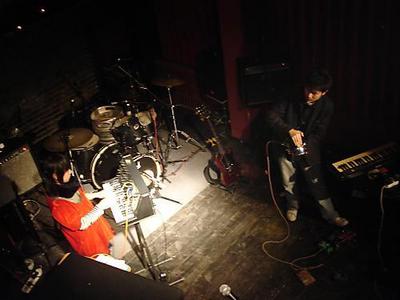
White performing at D-22, Beijing, November, 2008.
6. Liang Yuanwei, BLDG 115, RM 1904 (Boers-Li Gallery, Beijing)
Against the backdrop of a Chinese art world that is rapidly and oftentimes inelegantly commercializing, Liang Yuanwei's solo show at Boers-Li Gallery was a steady, measured gesture. Her heavily textured oil paintings explored the decorative and fine arts traditions of the medium with a lingering and understated grace, a slow-cooked approach that is quiet and lasting.
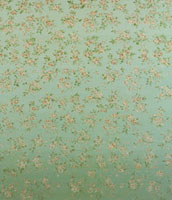
Liang Yuanwei, A Piece of Life 6, 2006-07, oil on canvas, 140 x 120 cm.
7. Video works of Li Yongbin
Li Yongbin's works weren't exhibited this year, but I had the chance to watch his entire output in the course of other research. Long, slow, and devastating, Li makes video art that seems to straddle performance and abstraction. These are serious and rewarding pieces that deserve to come to more light.
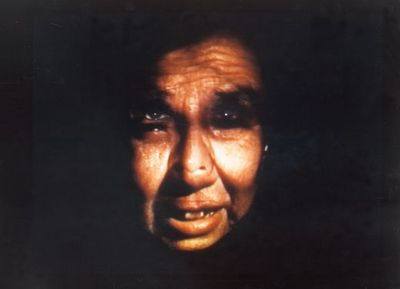
Li Yongbin, Face 1, 1996, still from a color video, 60 minutes.
8. "House of Oracles: A Huang Yong Ping Retrospective" (Ullens Center for Contemporary Art, Beijing)
The show came from Minneapolis and North Adams by way of Vancouver, but it was a happy presence in Beijing. Have we blown our shot for another traveling exhibition of a similar standard?
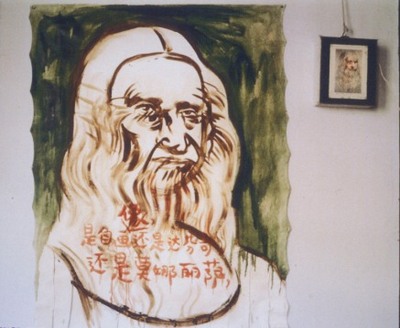
Huang Yong Ping, Mona-Vinci, 1986-87, oil on paper and framed textbook illustration.
9. Lawrence Weiner, lecture at the Central Academy of Fine Arts (January 11, 2008)
In town for an installation at UCCA, Weiner's talk to an audience full of eager minds at the Central Academy of Fine Arts opened a window onto a rigorous and provocative system of thought that gave many much to chew on for a long time afterward.

Lawrence Weiner and translator Weng Wei at the Central Academy of Fine Arts, January, 2008.
10. New Pants, closing performance at the Modern Sky Festival (October 2, 2008)
China doesn't give the right stage even to its most seasoned successes: at their November launch party at Yugong Yishan, the New Pants were cramped by the venue, their luster lacking for want of size and scale. It's clear that these are personalities that need space to fill and expand, and after twelve years of making music, it's going to be a challenge for Beijing's music boxes to sustain their careers and their interest. New Pants' closing performance at the Modern Sky Festival in October offered song after anthemic song, each building on the emotional swell of the last, until the band closed with "This is Our Generation," and the audience believed every word when Peng Lei started it by saying, "After all these years, it still comes down to this one song."
Angie Baecker is a book editor and critic based in Beijing.
— 文/ Angie Baecker
2008.12.18
1. Ai Weiwei's 1980s New York photographic archive
Ai Weiwei lived in for twelve seminal years in the United States, leaving in his wake a prolific stream of photographs trained upon zeitgeists both internal and external, Chinese and American. When he left New York in 1993, he was deep in the East Village scene. References to those expatriated years have been constant since his return to China, building the shape and authority of his voice. But Ai's documentation of that time has not entered the public realm until now. Beijing's Three Shadows Photography Art Center has undertaken the organization, preservation, and partial publication of this incredible archive, with an exhibition to go on view in the new year. The archive offers a precious window onto the times, Ai's presence, and their combined significance.

An Orthodox family visits Liberty Island, from Ai Weiwei's New York photographic archive, ca. 1986.
2. Wu Shanzhuan, But Still Red, Red Humour International (Guangdong Museum of Art, Guangzhou)
Wu Shanzhuan is the practical joker of his generation: anyone who can discuss the performance in which Wu masturbated into a cucumber without a sense of humor is guilty of desiccating art. The mainland-produced retrospective was a step in the right direction—a decently curated show dedicated to a deserving artist. Here's to hoping there are more where that came from.

View of "Wu Shanzhuan, But Still Red, Red Humour International," 2008, Guangdong Museum of Art, Guangzhou.
3. Wang Gongxin, Synchronization, ("Christian Dior and Chinese Artists," Ullens Center for Contemporary Art, Beijing)
Deep in the hallways of one of the more swollen of exhibitions to be staged in Beijing this year, a video projection shows runway models sashaying forward in fabulous Dior designs. A parallel projection faces off with it, fat and forward street models strutting in crude fabrications of the originals. The schadenfreude is sustaining: chub and flab don fashion drag to devastating effect, deflating the pretension of skin and bones— and under the auspices of its worst offenders, no less! Synchronization is a cheeky crystallization of the emperor's new clothes syndrome that seems to have defined the year in art: all this pomp and fuss, but what about substance?

Wang Gongxin, Synchronization, 2008, multi-screen video installation.
4. '85 New Wave Archive series (Edited by Fei Dawei, volumes 1 and 2 published by Ullens Center for Contemporary Art)
Pages upon pages of scans of handwritten notes, sketches, photos, and mementos from the 1980s by Fei Dawei and the cluster of shining expatriated art stars that surrounded him, this series of documents from the '85 New Wave archives is field upon field of raw bounty for future researchers. The next four titles in the series are suspended for the time being, but once more, here's to hoping more good content will find a way to get out.

Cover of '85 New Wave Archive, vol. II, Fei Dawei ed., Ullens Center for Contemporary Art, Beijing, 2007.
5. White at D-22 (November 16, 2008)
Zhang "Jeffray" Shouwang and Cosmic Shenggy only get to play together a few times a year: he's the frontman for the earnest Carsick Cars, posterband for Beijing's rising underground music scene, and she's in London studying sound engineering and philosophy. But on the rare occasion when they do get to perform together, you just need to be there. White exemplifies their experimental label, and accordingly, material at each performance varies wildly. This November 16 performance at D-22 was, to use Shenggy's own descriptor, an exercise in "cosmic industrial": magical, heavy, soaring, and probing. This is music with its eyes full of stars, bass that soaks in through your pores, a moment that can only be communicated live.

White performing at D-22, Beijing, November, 2008.
6. Liang Yuanwei, BLDG 115, RM 1904 (Boers-Li Gallery, Beijing)
Against the backdrop of a Chinese art world that is rapidly and oftentimes inelegantly commercializing, Liang Yuanwei's solo show at Boers-Li Gallery was a steady, measured gesture. Her heavily textured oil paintings explored the decorative and fine arts traditions of the medium with a lingering and understated grace, a slow-cooked approach that is quiet and lasting.

Liang Yuanwei, A Piece of Life 6, 2006-07, oil on canvas, 140 x 120 cm.
7. Video works of Li Yongbin
Li Yongbin's works weren't exhibited this year, but I had the chance to watch his entire output in the course of other research. Long, slow, and devastating, Li makes video art that seems to straddle performance and abstraction. These are serious and rewarding pieces that deserve to come to more light.

Li Yongbin, Face 1, 1996, still from a color video, 60 minutes.
8. "House of Oracles: A Huang Yong Ping Retrospective" (Ullens Center for Contemporary Art, Beijing)
The show came from Minneapolis and North Adams by way of Vancouver, but it was a happy presence in Beijing. Have we blown our shot for another traveling exhibition of a similar standard?

Huang Yong Ping, Mona-Vinci, 1986-87, oil on paper and framed textbook illustration.
9. Lawrence Weiner, lecture at the Central Academy of Fine Arts (January 11, 2008)
In town for an installation at UCCA, Weiner's talk to an audience full of eager minds at the Central Academy of Fine Arts opened a window onto a rigorous and provocative system of thought that gave many much to chew on for a long time afterward.

Lawrence Weiner and translator Weng Wei at the Central Academy of Fine Arts, January, 2008.
10. New Pants, closing performance at the Modern Sky Festival (October 2, 2008)
China doesn't give the right stage even to its most seasoned successes: at their November launch party at Yugong Yishan, the New Pants were cramped by the venue, their luster lacking for want of size and scale. It's clear that these are personalities that need space to fill and expand, and after twelve years of making music, it's going to be a challenge for Beijing's music boxes to sustain their careers and their interest. New Pants' closing performance at the Modern Sky Festival in October offered song after anthemic song, each building on the emotional swell of the last, until the band closed with "This is Our Generation," and the audience believed every word when Peng Lei started it by saying, "After all these years, it still comes down to this one song."
Angie Baecker is a book editor and critic based in Beijing.
— 文/ Angie Baecker